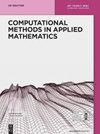基于bem的集成Kálmán滤波磁场重建
IF 1.2
4区 数学
Q3 MATHEMATICS, APPLIED
引用次数: 0
摘要
摘要普通或超导电磁铁产生的磁场用于引导和聚焦存储环、同步加速器光源、质谱仪和放射治疗光束线中的粒子束。通过测量准确确定磁场对于预测粒子束轨迹以及因此设计加速器复合体至关重要。在这种情况下,最先进的数值场计算利用边界元方法来表达磁场。这使得能够精确计算用于粒子跟踪的有效数值代码中的磁势的高阶偏导数和局部展开。在本文中,我们提出了一种通过系综Kálmán滤波从磁场测量推断间接边界元公式的边界数据的方法。通过这种方式,测量不确定性可以传播到边界数据、磁场和电势,以及从粒子跟踪导出的与束相关的量。我们提供了使用霍尔探针映射器系统从弯曲偶极磁体的实际测量数据中获得的结果。本文章由计算机程序翻译,如有差异,请以英文原文为准。
BEM-Based Magnetic Field Reconstruction by Ensemble Kálmán Filtering
Abstract Magnetic fields generated by normal or superconducting electromagnets are used to guide and focus particle beams in storage rings, synchrotron light sources, mass spectrometers, and beamlines for radiotherapy. The accurate determination of the magnetic field by measurement is critical for the prediction of the particle beam trajectory and hence the design of the accelerator complex. In this context, state-of-the-art numerical field computation makes use of boundary-element methods (BEM) to express the magnetic field. This enables the accurate computation of higher-order partial derivatives and local expansions of magnetic potentials used in efficient numerical codes for particle tracking. In this paper, we present an approach to infer the boundary data of an indirect BEM formulation from magnetic field measurements by ensemble Kálmán filtering. In this way, measurement uncertainties can be propagated to the boundary data, magnetic field and potentials, and to the beam related quantities derived from particle tracking. We provide results obtained from real measurement data of a curved dipole magnet using a Hall probe mapper system.
求助全文
通过发布文献求助,成功后即可免费获取论文全文。
去求助
来源期刊

Computational Methods in Applied Mathematics
MATHEMATICS, APPLIED-
CiteScore
2.40
自引率
7.70%
发文量
54
期刊介绍:
The highly selective international mathematical journal Computational Methods in Applied Mathematics (CMAM) considers original mathematical contributions to computational methods and numerical analysis with applications mainly related to PDEs.
CMAM seeks to be interdisciplinary while retaining the common thread of numerical analysis, it is intended to be readily readable and meant for a wide circle of researchers in applied mathematics.
The journal is published by De Gruyter on behalf of the Institute of Mathematics of the National Academy of Science of Belarus.
 求助内容:
求助内容: 应助结果提醒方式:
应助结果提醒方式:


